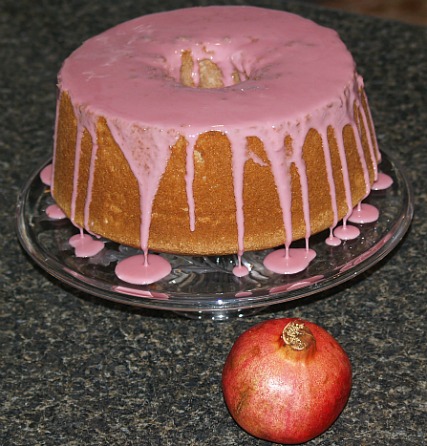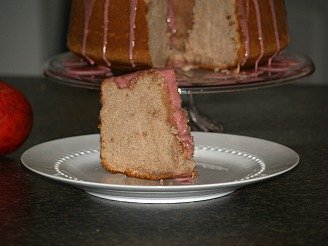- Painless Cooking
- Desserts
- Pomegranates
How to Make Recipes for Pomegranates
If you are learning how to make recipes for pomegranates, they can be made much like using cranberries. Although they are a fruit, the sweet sour flavor blends well and can be used in many entrees or appetizers like meatballs. When I think of this fruit, of course I think of a sweet and delicious pomegranate cake recipe.
NOTE: Pomegranates will stain your hands, clothes and anything the juice gets on. TAKE CAUTION!
In the United States, the majority of pomegranates are produced in the drier areas of California and in Arizona where the winters are mild. This fruit was introduced to these areas by the Spanish settlers in the seventeen hundreds. Sometimes people in Hawaii will also plant them in their gardens. They can be found as far north as Washington DC, however northern plants do not produce any fruit.
People have learned how to make recipes for pomegranates since ancient times and have been mentioned in many of the ancient written text. It is native to Iran and other Middle Eastern countries but is now grown in the Mediterranean area of Southern Europe, northern Africa, parts of Asia, Latin America and other parts of the world.
A pomegranate is the fruit of a very large bush which have been known to live for hundreds of years although the fruit production stops after a few decades. This fruit is about the size of a small orange turning from a yellowish color to a pretty red color when ready to eat. Inside the shell is a juice filled sac full of red seeds (or berries) called arils.
These arils are filled with a sweet and sour juice which surrounds little white seeds. Both the juice and seeds are edible. The white membrane in the arils and the rind of the pomegranates are very bitter and is recommended that they be discarded. If eating this fruit for its nutritional value these parts also rank very high even though they are not so tasty.
After separating the arils from the membranes, they can be stored in the refrigerator for up to three days. To freeze them, place on a tray in a single layer. After freezing place the seeds in an airtight container and store in the freezer. If you are learning how to make recipes for pomegranates, remove only the seeds that you will be using from the freezer and use them in the recipe while frozen. They will lose their shape if you allow them to thaw out.
You can store whole pomegranates at room temperature, out of the sunlight quite well for several days. If refrigerated in plastic bags they will last for several months. If you choose to juice this fruit, it can be stored in the freezer for about six months.
Recipes for pomegranates can be made with this fruit as soon as they are purchased. Because they are such a good lasting quality, they are picked after they ripen. When you buy them, they are ready to use. The fruit will feel firm and heavy and be very full of juice. The skin coloring will be a medium to deep red. The leathery texture of the skin may not seem to be perfect but will not affect the quality of the fruit.
The arils (seeds or berries) can be used in many recipes for pomegranates like a variety of salad recipes, sprinkled over cereal, yogurt or ice cream. Most of the recipes for pomegranates consist of the deliciously flavored juice which comes from this fruit. Simply by running the berries through a juicer or blender, the juice can be used for marinades, cakes, pies, jellies etc.
MAKING POMEGRANATE JUICE
This is one of the most popular recipes for pomegranates.
Pomegranates can be juiced with a simple hand juicer or electric, a blender or by rolling the berries or a hard surface. Make a cut beginning at the crown half way down through the fruit. Open the fruit with your fingers over a clean bowl filled partially full with fresh water so any juice or berries will fall into the bowl.
Make another cut on each half of the fruit beginning at the crown; pull apart each half. Working gently with your fingers to remove seeds from fruit letting them drop into the bowl. Take caution to remove the white membrane from the fruit so the juice does not become bitter.
To make pomegranate juice in a blended, place 1 to 2 cups of seeds in the blender after separating them from the fruit. Process until liquefied and then strain through a cheesecloth lined strainer. Juice can also be made by placing the berries in a plastic freezer bag and pressing with your hands until they bread and produce juice. Roll gently with a rolling pin until all the juice is out and then strain. To remove any sediment from the juice, strain through a cheesecloth lined strainer.
Health conscious individuals look at this “divine fruit” as a “super food” which offers many health benefits whether used in recipes for pomegranates or as a simple snack or juice. For thousands of years this fruit has been a source of natural medicine; a good source of fiber with very low calories. The juice is very high in potent antioxidants, vitamin C and potassium. It is used to reduce body heat and is helpful for those who have low blood pressure.
Pomegranate extract is great for fighting bad breath and other oral problems like plaque buildup. The extract is also known for slowing down the aging process. The juice and seeds of this fruit reduces cholesterol and helps to fight heart disease. The rind and bark of the pomegranates are used for hemorrhoids and such intestinal problems like diarrhea, dysentery and parasites.
POMEGRANATE CIDER RECIPE
- 1 Bottle (64 ounces) cranberry juice
- 1 Bottle (64 ounces) pomegranate juice
- 1 Can (48 ounces) pineapple juice
- ½ Cup sugar
- 1 Tablespoon whole cloves
- 1 Sliced seeded orange
- 3 Cups bourbon
- Orange slices and cranberries for garnish
Combine in a large Dutch oven the cranberry juice, pomegranate juice and pineapple juice.
Add sugar, cloves and orange slices; bring to a simmer over medium heat for 20 minutes.
Remove the cloves and stir in the bourbon.
Serve hot and garnish with cranberries and additional orange slices.
POMEGRANATE SPONGE CAKE RECIPE one of the delicious recipes for pomegranates
NOTE: I FEEL THE POMEGRANATE DOES NOT HAVE A STRONG FLAVOR WHEN USED IN RECIPES. Even though the flavor of the pomegranate juice is not “recognizable” to me in the cake recipe below, it still has a great taste and a wonderful moist texture.
- 3 Cups sifted flour
- 2 Teaspoons baking powder
- 6 Eggs separated
- 2 Cups sugar
- 1 Cup pomegranate juice
- 1 Teaspoon vanilla
Combine sifted flour and baking powder; sift again together.
Beat egg yolks until light; add 1 ½ cups of the sugar slowly while beating.
Add flour to the yolk mixture alternating with the juice.
Combine salt and cream of tartar with egg whites.
Beat egg whites until foamy; gradually add ½ cup sugar beating to stiff peaks.
Fold beaten egg whites into the batter.
Spoon mixture into an ungreased tube cake pan; bake at 350F degrees for 55 minutes.
Remove from oven and invert until cold. (Hang pan on a heavy glass bottle or prop up about 2 inches)
Run knife around edges to loosen cake; remove sides of tube pan and loosen bottom with a knife.
NOTE: I made a glaze with 1 ½ cup powdered sugar and enough pomegranate juice for consistency. You can also slice the cake horizontally and fill with the pie filling recipe below.
POMEGRANATE PIE FILLING RECIPE
This can be used to make a couple recipes for pomegranates a meringue pie or as a filling for the above cake recipe.
- 2 Cups pomegranate juice
- 1 Cup sugar
- ¼ Cup cornstarch
- 3 Eggs separated (Beat yolks for filling; set whites aside to whip for meringue)
Combine sugar, cornstarch and juice in a medium size saucepan.
Heat over medium temperature stirring until smooth and thickened.
Pour small amount of hot mixture into beaten egg yolks (stir briskly to blend)
Add yolk mixture into pot with remaining pomegranate mixture.
Stir over heat about five minutes longer until yolks cook and thicken.
Pour into baked and cooled pie shell.
TO MAKE MERINGUE beat 3 egg whites with a pinch of salt until soft peaks form. Gradually beat in 2 tablespoons of sugar and beat until stiff peaks. Spread over pie filling and bake in preheated oven at 400F degrees until meringue has browned.






